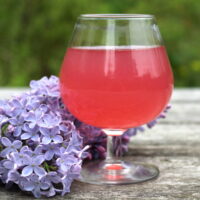Lilac Wine
Lilac wine captures the sweet floral flavor of lilacs into delicious wine.
Servings: 20 glasses (1 gallon, about 4 bottles)
Ingredients
- 6 cups lilac blossoms stems and green parts removed
- 5 1/2 to 6 cups sugar
- 1 handful blueberries optional, for color
- 3 to 4 medium lemons juiced
- 1 tsp yeast nutrient
- 1/8 tsp tannin powder optional
- wine yeast
Instructions
- Clean lilac blossoms, removing everything but the actual flower. Place them in a fermentation vessel.
- Bring 2-3 quarts of water to a boil on the stove, add sugar and a few blueberries (optional). Stir to dissolve the sugar. Allow the syrup to cool completely before proceeding. It can help to do this part first, then start cleaning the blossoms.
- Pour the cooled syrup over the lilac blossoms, add lemon juice, yeast nutrient and tannin powder (if using).
- Fill a small cup with water and add the wine yeast. Allow the yeast to rehydrate for at least 5 minutes before adding it to the wine (adding it directly can shock the dormant yeast).
- Cap the fermenter with a water lock and allow the mixture to ferment in primary for 7 to 10 days, cleaning out the water lock if necessary.
- After primary, use a siphon to rack the wine into a clean fermenter, leaving the flowers and sediment behind.
- Ferment in secondary for 2-3 months (or up to 6 months) before bottling. Racking again during this time will result in a less cloudy finished wine.
- Bottle in wine bottles and store in a cool, dark place. Allow the wine to bottle condition for at least 2 months, but preferably 6 months before drinking.
Nutrition
Calories: 212kcal | Carbohydrates: 55g | Fat: 0.2g | Sodium: 1mg | Potassium: 1mg | Sugar: 55g | Calcium: 1mg | Iron: 0.03mg
